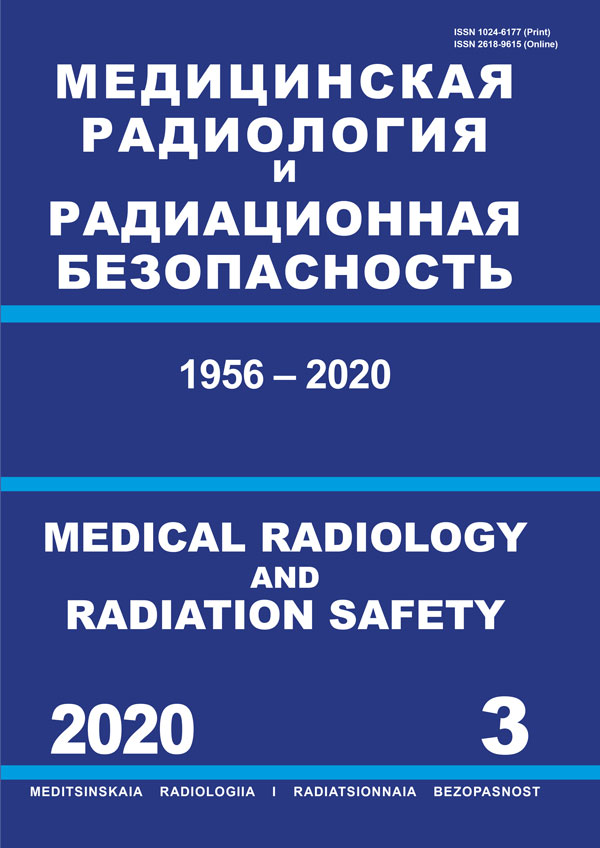GRNTI 34.03 Теоретическая биология
Purpose: To investigate the effect of niclosamide on the radiosensitivity of MCF-7 cancer stem cells (CSC) and to explore the molecular mechanism of radiosensitization. Material and methods: Cancer stem cells were obtained from MCF-7 mammary adenocarcinoma monolayer culture (2D) and propagated as mammospheres (3D) in serum-free DMEM/F12 supplemented with EGF, bFGF, B 27, heparin, and insulin in ultra-low attachment plates. The single cell suspensions were irradiated with 1, 2, 4, 6, and 8 Gy using 60Co source at a dose rate of 0.54 Gy/min. Controls were sham irradiated. The size of the CD44+/CD24-/low CSC fraction was measured using flow cytometry at the 7th and 14th days after irradiation. The radiosensitizing effect of niclosamide on the 2D- and 3D-cell cultures was assessed by the number of cells at the 7th and 14th days after irradiation with doses of 2 or 4 Gy. Niclosamide was added to the cell cultures in a dose of 2 µM 1 h before irradiation. Media with niclosamide were changed to corresponding media without niclosamide 24 h post-irradiation. Cell survival was evaluated by hemocytometer cell counting using trypan blue. The size of the CSC fraction was measured at the 7th day after the irradiation with or without niclosamide. To investigate the effect of niclosamide on DNA damage the level of histone γH2AX was measured by flow cytometry at 60 min after irradiation. Results: Culturing adherent MCF-7 cells line under non-adherent mammosphere-forming conditions led to significantly increase in CSCs proportion. CD44+/CD24–/low cell fraction in 2D-culture was 0.2 ± 0.1 %, and it was 3.2 ± 0.6 % in 3D-culture (the third-generation spheres). Subpopulation of CSCs increased with the increase in irradiation dose. At day 14 after irradiation with the dose of 8 Gy, CD44+/CD24–/low cell fraction in 2D-culture was 2.2 ± 0.6 %, and it was 12.0 ± 0.9 % in 3D-culture. Cells grown in mammosphere-culture were found to have a higher survival rate after irradiation at doses of 2 and 4 Gy than cells grown in adherent conditions. At day 7 after irradiation with 2 and 4 Gy the 3D-culture cells counts decreased less than the 2D-culture cells counts (92 ± 13 % and 61 ± 10 % versus 58 ± 4 % and 37 ± 3 % compared to non-irradiated control). Moreover, cells grown in mammosphere-culture showed a higher renewal capacity. At day 14 after irradiation with 2 and 4 Gy the number of 3D-culture cells was 66 ± 11 % and 30 ± 7 % while the number of adherent cells was 43 ± 2 % and 7 ± 1 % compared to non-irradiated control. It was found that niclosomide has radiosensitizing effect on cells grown in mammospheres. Pretreatment with niclosamide 1 h prior to irradiation resulted in decrease in cell survival. At day 7 after irradiation at 2 and 4 Gy in the presence of niclosamide, the numbers of 3D-culture cells were reduced by 13 % and 7 % compared to their numbers after irradiation with appropriate doses in the absence of niclosamide. Furthermore, niclosamide was shown to reduce the percentage of CSCs. At day 7 after irradiation with 2 and 4 Gy, 3D-culture showed elevated percentages of CD44+/CD24−/low cells: CSC fraction in mammospheres were 4.6 ± 0.3 % and 6.1 ± 0.5 %, respectively, and after pretreatment by niclosamide and irradiation the sizes of the CSC fractions were 2.5 ± 0.1 % and 4.0 ± 0.3 %, respectively. Radiosensitizing effect of niclosamide lasted for 2 weeks. At day 14 after irradiation at 2 and 4 Gy in combination with niclosamide the numbers of 3D-culture cells were reduced by 13 % and 9 % compared to cell numbers after irradiation with appropriate doses without of niclosamide. Radiosensitization of cells grown in mammospheres might be related with increase in DNA double-strand breaks (DSB) prodused by niclosomide. At 1 h after 2 and 4 Gy irradiation cells grown in mammospheres shown 2.4-fold and 4.8-fold increase in DNA DSB, as indicated by γH2AX levels, compared to baseline. The combined treatment of niclosamide and irradiation with 2 and 4 Gy resulted in 3.4-fold and 5.5-fold increase in the levels of histone γ-H2AX, respectively. Conclusion: Niclosamide increased the radiosensetivity not only of the bulk cells of mammary adenocarcinoma line MCF-7 but also of CSCs. The radiosensitizing effect of niclosamide was associated with increase in the level of DNA damage.
niclosamide, γ-radiation, MCF-7cell line, cancer stem cells, human breast adenocarcinoma, radioresistance, radiosensitization
Современные представления о механизме канцерогенеза связаны с признанием существования опухолевых стволовых клеток (ОСК) – клеток, которым принадлежит ключевая роль в инициации и развитии опухолевого процесса. В сόлидных опухолях ОСК впервые были обнаружены M. Al-Hajj и соавторами, которые показали, что только небольшая популяция клеток с фенотипом CD44+CD24-/lowESA+ (ESA – epithelial-specific antigen – специфический для эпителиальных клеток антиген) способна индуцировать развитие опухолей при их трансплантации иммунодефицитным мышам. Впоследствии были накоплены убедительные доказательства присутствия ОСК в различных типах сόлидных опухолей человека.





